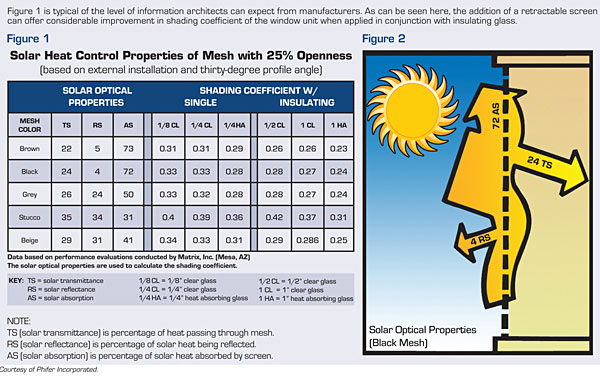Comfort on Demand
Sustainability and Other Design Considerations
Retractable screens contribute to sustainability in a number of ways.
Lowering the Shading Coefficient
Expressed as a decimal between 0 and 1, shading coefficient represents the percentage of solar heat gain that is transmitted through a shading system into a building, compared to that of a single pane of clear 1/8-inch (2.54-centimeter) glass. The lower the shading coefficient, the lower the heat gain through the material, and thus the better the solar control performance. A typical low-E glass would have a shading coefficient in the area of .3.
A black screen mounted externally that has a 25 percent openness factor will deliver similar solar heat gain coefficient results to an oyster/beige screen mounted internally that has a 5 percent openness factor. The advantage is that the black exterior screen will be much easier to see through and it will also absorb glare, whereas the light colored interior screen will produce glare.
Architects can consult manufacturers for information about how screens improve the shading coefficient of clear and heat absorbing glass as well as information on optical properties of products. (Refer to figures 1 and 2 in the online section of this course.)
Visibility and Views
Retractable screens have differing levels of opaqueness, or openness. The openness factor refers to the density of the weave, and is the percentage of open area to the total area of the fabric. The higher the screen's openness factor, the clearer the outward view and the better its ventilation potential - but the more solar heat and glare it will transmit. Conversely, lower openness screens block more UV rays, but the view or ventilation won't be as good. As view quality increases, UV ray blockage decreases. A screen with a 25 percent openness factor, for example, may offer a superior view, but block only 75 percent of the UV rays, while a screen with an openness factor of 5 percent will block 95 percent of UV rays or more, but the view won't be as clear.
In windy areas, unless there is a solid structure behind the screen, it is advisable to select a more open mesh that allows the breeze to travel through it, reducing the chance of excessive tension on the screens.
Sustainability Benefits of Retractable Screens
Retractable screens contribute to a sustainable building in several ways.
Improved Daylighting
By reducing glare and heat gain, manually and motorized retractable screens add to a building's daylighting strategy. Retractable screens can easily be used only when they are needed so daylight can be maximized, which offers significant payoffs in energy efficiency via less artificial lighting and less air conditioning to counteract the electric lighting load; as well as in improving human performance and well being. This is also true for motorized retractable screens being used on the exterior for solar control - the user has the ability to control daylight.

According to the U.S. Department of Energy's Federal Energy Management Program, daylighting can significantly cut lighting energy use for building interiors, by as much as 75 to 80 percent, depending on the application. Daylighting is also known to have a salutary effect on a wide range of human activities. Studies by the Heschong Mahone Group have shown students increase their test scores in daylighted classrooms, sales increase in daylighted retail stores, and productivity increases for office workers.
In her paper "Investing In People: The Social Benefits of Sustainable Design," Judith Heerwagen Ph.D., Principal, J.H. Heerwagen & Associates based in Seattle, finds buildings that incorporate a connection to nature and natural sunlight improve occupants' well-being, stress levels, cognitive performance, and satisfaction with life and work.
So important is daylighting that it is now either required or encouraged in certain instances by a host of national and state organizations including California's Title 24 energy code, the Oregon Energy Code, LEED-NC v.3, Northeast Collaborative for High Performance Schools, ASHRAE and countless other organizations. The latest generation of codes such as International Energy Conservation Code 2009 and Title 24, ASHRAE 90.1-2010 and ASHRAE 189.1 are beginning to require daylighting control - an area where retractable motorized screens can form part of the solution.









